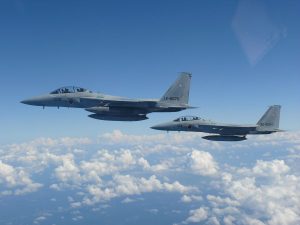Spatial disorientation of the two pilots was likely the cause of the crash of a Japan Air Self-Defense Force (JASDF) Mitsubishi-Boeing F-15DJ Eagle fighter aircraft in January, the JASDF said in a press release on June 2.
This was the second crash of a JASDF aircraft due to pilots possibly experiencing spatial disorientation or vertigo in less than three years.
The twin-seat operational trainer aircraft, tail number 32-8083, fell into the Sea of Japan about 5.5 kilometers west-northwest of Komatsu Air Base in Ishikawa Prefecture soon after taking off at around 5:30 p.m. on January 31. The two crew members on board were killed. The fighter was on its way to a nighttime training mission.
Based on the result of a four-month investigation into the crash, the JASDF concluded that the two pilots were highly likely to have suffered spatial disorientation when their aircraft was considerably turning to the right, while ascending. The fighter’s nose then gradually lowered before it started a rapid descent.
The service said that about two seconds before the crash, the pilots are believed to have tried to bring the jet back to its normal flight course, but failed to do so in time.
Noting the aircraft had been flying in dense clouds, the JASDF concluded that the pilots were highly likely to have been experienced vertigo and may have lost their sense of equilibrium, which made it difficult for them to recognize which way was up.
The JASDF pilots who died in the crash were both veterans. One had about 2,800 hours of flight time and the other about 1,900 hours. Even veteran pilots can experience vertigo in rare cases.
The JASDF had a similar crash that was also likely caused by spatial disorientation of a pilot. The Japanese Ministry of Defense (MoD) announced in June 2019 that the pilot experiencing vertigo likely the cause of the crash of a JASDF F-35A Lightning II Joint Strike Fighter aircraft in April 2019 into the Pacific Ocean.
This time, the JASDF stressed that the service will strengthen education and training about spatial disorientation, as well as the research and study of the system that automatically detects any abnormal position and alerts the pilots in order to avoid a crash. The service aims to introduce such crash avoidance into aircraft in the future.

































